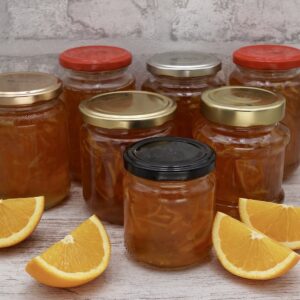
Seville orange marmalade
Seville orange marmalade is a sweet citrussy preserve made using the juice and peel of oranges. It is delicious served for breakfast on hot toast. It can also be used as a filling for cakes or used as a topping for ice cream or other desserts.
Ingredients
- 1 kg Seville oranges
- 1 lemon juice
- 2 kg sugar
- 1.75 litres water
Instructions
Prepare the oranges
- Lightly scrub the oranges to remove any traces of contaminants and cut the oranges in quarters and remove the insides. Squeeze the juice into the pan either by hand or using a juicer. Place the orange peel and the segments in a container with 1.75 litres water. Either leave to soak overnight or proceed to make the marmalade.
Cook the oranges
- Place the cut oranges, insides of the oranges (including the pips) and the water that they have been soaking in in a large pan. Bring to the boil and simmer until the orange peel has softened. (Around 30 minutes for oranges soaked overnight. Otherwise around 2 hours).
- Strain the liquid off and set the liquid aside. Place the orange peel onto a board ready to cut into shreds.
- Squeeze any remaining juice out of the orange segments and discard the solids (insides of the oranges and pips).
Cut the orange peel
- Scrape the pith off the inside of the orange peel and cut the peel into small strips using a sharp knife. You can cut the peel either finely or coarsely but ideally cut into uniform lengths and thicknesses for a better appearance.
Cook to setting point
- Return the liquid to the pan and add the orange shreds and lemon juice.
- Weigh the sugar into an ovenproof dish and heat in the oven at a low setting. The sugar doesn't need to be hot, just warm to the touch so that it will dissolve more quickly when added to the pan.
- Add the warmed sugar to the pan with the orange juice and heat gently until the sugar has dissolved. You can check the sugar has fully dissolved by stirring with a wooden spoon and checking to see if any sugar crystals remain.
- This is a good time to pop your jars and lids in the oven to sterilise them.
- Divide into two batches. When boiling the marmalade rapidly the bubbles will rise up the pan. Here I have used a heavy bottomed pan 20cm (8") in diameter and 14cm (5.5") deep and find it works better to carry out the rapid boil in two batches.
- Return half the liquid to the heavy bottomed pan and turn up the heat and boil rapidly without a lid for 10 minutes. If you have a sugar thermometer boil at around 104oC to 105oC (220oF to 221oF).
- After the marmalade has reached setting point you can repeat with the second batch.
Test for setting point
- Remove the pan from the stove so that the marmalade doesn't continue to cook.
- Take one of the plates out of the freezer and remove the pan from the heat. Place a teaspoonful of the marmalade and place it on the plate. When the sample of marmalade has cooled push it with your finger. If the surface wrinkles then setting point has been reached.
- If the sample of jam does not wrinkle, return the pan to the heat and boil rapidly for another 5 minutes and then check again. Repeat until setting point is reached.
- Leave to cool for around 20 minutes and then transfer to the sterilised jars.
Notes
Note
The estimated preparation time is based on soaking the oranges overnight.
Tips
- Zest the lemon before juicing and save the zest to use in another recipe such as French lemon tart, lemon and poppy seed shortbread, lemon drizzle cake or lemon cheesecake.
- Make sure the sugar has completely dissolved before turning up the heat for the rapid boil. Undissolved sugar will result in sugar crystals in the finished marmalade.
- Remove the pan from the stove before carrying our the wrinkle test. If the test indicates the marmalade has reached setting point and the marmalade continues to boil it is likely to become overcooked.
- Once setting point is reached leave to cool for around 20 minutes before transferring to the sterilised jars. When the marmalade is hot the shreds will float to the top. As it cools it will become thicker and be able to support the shreds. As the marmalade cools used a clean utensil to push some of the orange shreds deeper into the marmalade to aim for an even distribution of shreds.
- The setting point of marmalade will vary with significant changes in altitude. The Bake School has useful and interesting information on marmalade making including marmalade setting point and is well worth taking a look before you make your batch of marmalade.
- Serve on toast for breakfast or a snack.
- Use as a drizzle for cakes such as orange and ginger drizzle cake.
- Stir into rice pudding for extra flavour.
- Use as a topping for ice cream such as straciatella ice cream.
- Drizzle over vegetables while cooking such as roast parsnips or hasselback carrots.
Nutrition
Calories: 1363kcalCarbohydrates: 352gProtein: 2gFat: 1gSaturated Fat: 0.03gPolyunsaturated Fat: 0.04gMonounsaturated Fat: 0.04gSodium: 18mgPotassium: 313mgFiber: 4gSugar: 348gVitamin A: 375IUVitamin C: 91mgCalcium: 79mgIron: 0.3mg
Tried this recipe?Let us know how it was!